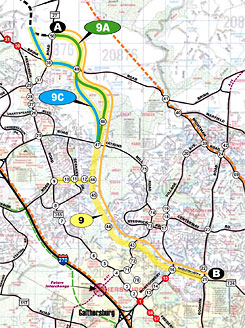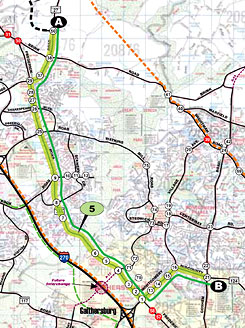Montgomery backtracks on a sprawl-inducing highway
After a decade-long process, it looked like Montgomery County was pushing ahead with a new highway through streams and wetlands at the edge of the county’s built-up areas. But last week, county officials announced they don’t support the road project after all.
In March, the county Department of Transportation issued a report recommending a new limited-access highway, around the edge of developed areas. The road, designated M-83, would approximately parallel I-270 and MD-355 but farther east, connecting the east side of Clarksburg to the current Midcounty Highway, Route 124.
This dismayed advocates who had been asking the county instead to study ways to better connect to Clarksburg with transit and fixes to local roads. Last week, DOT Acting Director Al Roshdieh put out a statement essentially repudiating the DOT’s earlier recommendation:
The County Executive does not support building this road, he did not recommend the preferred alternative, nor was it an option that I as MCDOT acting director recommended. Further, there is no funding proposed for the project in the County’s capital budget.
The study, “Draft Preferred Alternative/Conceptual Mitigation Report” (PA/CM) was conducted before the Route 355 Bus Rapid Transit (BRT) system was in the master plan, and therefore it was not considered as one of the alternatives. If BRT is considered, I believe the results of the PA/CM study and its recommended alternative could be significantly different. I strongly endorse this reassessment.
During my three months as MCDOT Acting Director, I continue to look for ways to promote a broader view of mobility in Montgomery County that is not necessarily wedded to building more roads. Taking a fresh look at various M-83 options, including the Route 355 BRT, is an important step in my vision for this department.
The council pushes M-83 out of limbo
In 1964, before the Clean Water Act had passed, Montgomery planners drew a future highway on maps to the east of MD 355. The road ran through wetlands and stream valleys to complete a “ladder and rung” network of arterial roads that would facilitate development in upcounty Montgomery. Since then, Midcounty Highway, also known as M-83, has been the subject of battles for over 50 years.
In its most recent chapter, the Montgomery County Council asked the county DOT in 2004 to study whether the highway, with its impacts to wetlands and streams, would be legal under modern environmental laws. Last year, DOT officials said they would complete the study in March of 2014, but were then silent about their progress for the rest of the year.
On March 2nd, the council’s Transportation and Environment Committee surprised MCDOT leadership by asking about the study. Members suggested that, if it was complete, it should go to federal regulators for a decision one way or the other. It appears that Council transportation staffer Glenn Orlin learned that the study had been finished for some time, and suggested that the committee ask for some resolution on the issue.
“If we’re not going to build it, we should take it out of the master plan”, he said in the committee session. “My understanding is that the report was done last summer and has not been sent to the feds. However you feel about the project, it’s delaying a resolution.”
Chair Roger Berliner said, “It’s no secret I’m not a big fan of this project. I’m even less a fan of ambiguity and being in limbo.” The committee members, while harboring different opinions about the project, all agreed that MCDOT should make the study public and send it to regulators. Berliner and fellow committee member Tom Hucker, along with a majority of council members, now publicly oppose to the project, while Nancy Floreen, the third member of the committee, supports it.
The county suggests a destructive option, then backs away
After getting the prod from the council, the DOT issued its report and recommended Alternative 9A, the original alignment from the 1960s master plan. At $350 million, it is the most expensive of the six alternatives analyzed, a price tag that doesn’t include environmental mitigation to compensate for the wetlands, floodplains, and forests it would damage.
In contrast to his agency’s position, County Executive Leggett has said he is against the road: shortly after the release of the study, a spokesperson for the County Executive told the Washington Post that Leggett “opposes the road project because of its cost.”
Throughout the study, it has been clear that the those in charge were building up arguments towards 9A. But more recently, top leaders who were most focused on building roads have left. Their replacements are already backing away from the controversial project.
WTOP reporter Ari Ashe tweeted recently that MCDOT Acting Director Al Roshdieh told him he was against M-83, and that it was “over.” After I mentioned the M-83 report in a list of cautionary notes about whether the DOT was really reforming, DOT spokesperson Esther Bowring called to say that Roshdieh considers the 9A option “dead.”
“If we don’t do this, we need to do something else”
During the March 2nd committee meeting, Councilmember Floreen said, “If we don’t do this, we need to do something else.” Many residents in Clarksburg rightly feel that the county made and broke many promises, including to build retail and provide good transportation. Development in Clarksburg was initially supposed to coincide with transit service, but the transit has not materialized.
However, this road is not the answer. It will only make new sprawl development, including up in Frederick and Carroll Counties, even more desirable, leading people to live there and work in Rockville, Bethesda, or DC, be dependent on cars, and clog the roads further for commuting and shopping.
The better solution for all upcounty residents is to build the transit that was promised in the first place. Berliner and many advocates have recommended building the study’s Alternative 2, a package of small widenings to congested intersections as well as new sidewalks and bike paths, and Alternative 5, which would widen MD-355 — but using the new lanes as dedicated lanes for BRT rather than new car capacity.
Bowring said that county officials are meeting next week to discuss next steps to reexamine the county’s recommendations and start moving toward, or at least seriously studying, the transit options that many residents are pushing for.
To fully put the idea of a new highway to rest, the county would have to remove it from the master plan. The decision to do that would be up to the county council, Berliner said, and the council could ask the planning department to be involved if it wished.
Unless something changes, the Army Corps of Engineers will go ahead and evaluate Alternative 9A. Some may be hoping the corps just tells Montgomery County it can’t build the road; that would forestall a local political battle between those who still want a new highway and the majority of the county council that doesn’t.
Either way, this 50-year battle is far from over.



